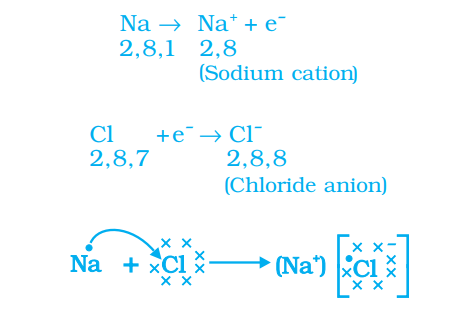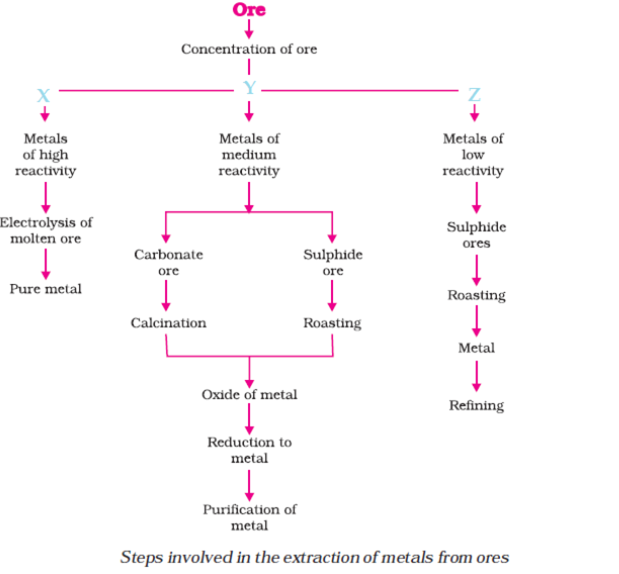Class 10 Metals and Non-metals Notes
Notes Previous Years Questions Important QuestionsMetals and Non-metals Notes
Physical properties of metals:-
- They are solid in state except mercury (liquid).
- They are malleable i.e., they can be beaten into thin sheet.
Gold and silver are most malleable metals. - They are ductile i.e., they can be drawn into thin wire.
Gold is the most ductile metal. - They are good conductors of heat and electricity.
Silver and copper are the best conductors of heat while lead and mercury are poor conductors of heat. - They have high melting and boiling point except gallium and caesium.
- They are very hard except lithium, sodium and potassium.
- They are lustrous i.e., they have shining surface.
- They are sonorous i.e., they produce a ringing sound on striking a hard surface.
Malleability:- The property of a metal by which it can be beaten into thin sheet is called malleability.
Ductility:- The property of a metal by which it can be drawn into thin wire is called ductility.
Sonority:- The property of a metal by which it produces a ringing sound on striking a hard surface is called sonority.
Lustre:- The shining property of metals is called lustre.
Physical properties of non-metals:-
- They can be solid, liquid or gas.
➢ Bromine is the only non-metal which is liquid. - They are non-malleable.
- They are non-ductile.
- They are bad conductors of heat and electricity.
➢ Graphite, a form of carbon is the only non-metal which is a good conductor of electricity. - They have varying hardness and are generally less hard.
➢ Diamond, a form of carbon is a non-metal which is the hardest natural substance known. - They have low melting and boiling point.
➢ Diamond has high melting and boiling point. - They are non-lustrous.
➢ Iodine is the only non-metal which is lustrous. - They are non-sonorous.
Chemical properties of metals:-
Reaction of metals with oxygen:-
- Metal + Oxygen → Metal Oxide
➢ 4Na + O2 → 2Na2O
➢ 4K + O2 → 2K2O
➢ 2Mg + O2 → 2MgO
- Metal oxides are basic in nature while non metallic oxides are acidic in nature.
- Some metal oxides dissolve in water to form alkalies. Ex:- Na2O, K2O etc.
➢ Na2O + H2O → 2NaOH
➢ K2O + H2O → 2KOH - Metals such as potassium and sodium react so vigorously that they catch fire if kept in the open. So, they are kept immersed in kerosene oil.
- At ordinary temperature, the surfaces of metals such as magnesium, aluminium, zinc, lead, etc., are covered with a thin layer of oxide which prevents the metal from further oxidation.
- Iron does not burn on heating but iron filings burn vigorously.
- Copper does not burn, but the hot metal is coated with a black coloured layer of copper(II) oxide.
- Silver and gold do not react with oxygen even at high temperatures.
Amphoteric oxides:- The metal oxides which react with both acids as well as bases to produce salts and water are known as amphoteric oxides.
Ex:- Al2O3 , ZnO etc.
- Al2O3
➢ Al2O3 + 6HCl → 2AlCl3 + 3H2O
➢ Al2O3 + 2NaOH → 2NaAlO2 + H2O
➢ NaAlO2 (Sodium aluminate) - ZnO
➢ ZnO + 2HCl → ZnCl2 + H2O
➢ ZnO + 2NaOH → Na2ZnO2 + H2O
➢ Na2ZnO2 (Sodium zincate)
Anodising:- The process of forming a thick oxide layer of aluminium on the surface of aluminium which prevents it from further corrosion is called anodising.
- During anodising, a clean aluminium article is made the anode and is electrolysed with dilute sulphuric acid.
Reaction of metals with water:-
- Metal + Water → Metal Oxide + Hydrogen
Metal oxide + Water → Metal hydroxide - Reaction of metals like sodium and potassium is so violent and exothermic that the evolved hydrogen catches fire.
➢ 2Na + 2H2O → 2NaOH + H2 + Heat
➢ 2K + 2H2O → 2KOH + H2 + Heat - The reaction of calcium with water is less violent and the heat evolved is not sufficient for the hydrogen to catch fire.
➢ Ca + 2H2O → Ca(OH)2 + H2
Here, Calcium starts floating because the bubbles of hydrogen gas formed stick to the surface of the metal. - Magnesium reacts with hot water. It also starts floating due to the bubbles of hydrogen gas sticking to its surface.
➢ Mg + 2H2O → Mg(OH)2 + H2 - Metals like aluminium, iron and zinc react with steam to form the metal oxide and hydrogen.
➢ 2Al + 3H2O → Al2O3 + 3H2
➢ 3Fe + 4H2O → Fe3O4 + 4H2 - Metals such as lead, copper, silver and gold do not react with water at all.
Reaction of metals with acids:-
- Metal + Dilute acid → Salt + Hydrogen
➢ Mg + 2HCl → MgCl2 + H2
➢ 2Al + 6HCl → 2AlCl3 + 3H2
➢ Zn + 2HCl → ZnCl2 + H2
- When a metal reacts with nitric acid (HNO3), hydrogen (H2) gas is not released because, HNO3 is a strong oxidising agent and it oxidises hydrogen (H2) produced to water (H2O) and itself gets reduced to nitrogen oxides (N2O, NO, NO2).
➢ Al + 6HNO3 → Al(NO3)3 + 3H2O + 3NO2 - Only magnesium (Mg) and manganese (Mn) react with very dilute HNO3 to evolve hydrogen gas.
➢ Mn + 2HNO3 → Mn(NO3)2 + H2 - Copper does not react with dilute HCl.
Aqua regia:- It is a mixture of concentrated hydrochloric acid (HCl) and concentrated nitric acid (HNO3) in the ration of 3:1.
- It is a highly corrosive, fuming liquid.
- It can dissolve gold (Au), platinum (Pt) even though neither of these acids can dissolve gold (Au) and platinum (Pt) alone.
Reaction of metals with solutions of other metal salts:-
- Displacement reaction:- The reaction in which highly reactive metal displaces less reactive metal from its salt solution is called displacement reaction.
- Metal A + Salt solution of metal B → Salt solution of metal A + Metal B
➢ 2K + FeSO4 → K2SO4 + Fe
➢ 3Ca + 2AlCl3 → 3CaCl2+ 2Al
Ionic/Electrovalent compound:-
The compound formed by the transfer of electrons from a metal to a non-metal is known as ionic compound. Ex:- NaCl, Na3PO4 etc.
Formation of NaCl:-

Properties of ionic compound:-
- The force of attraction between the ions is very strong.
- They are solid and hard.
- They are generally brittle.
- They have high melting point and boiling point because, they have high inter particle force of attraction.
- They are generally soluble in water but, insoluble in solvents like kerosene, petrol, etc.
- Ionic compounds do not conduct electricity in solid state but, conduct electricity in molten or aqueous state.
Occurrence of metal:-
Minerals:- The naturally occurring elements or compounds in the earth’s crust are called minerals.
Ores:- The minerals from which the metals can be extracted profitably are called ores.
Gangue:- The large amount of impurities such as soil, sand etc., present in the ores are called gangue.
Extraction of metals:-

Roasting:- The process of converting sulphide ores into oxides by strongly heating in the presence of excess air is called roasting.
Calcination:- The process of converting carbonate ores into oxides by heating strongly in limited air is called calcination.
Extraction of mercury (Hg) from its ore cinnabar (HgS):-
- Roasting:-
2HgS + 3O2 → 2HgO + 2SO2 - Reduction:-
2HgO → 2Hg + O2
HgS → Mercuric sulphide
HgO → Mercuric oxide
Extraction of copper from its ore copper sulphide (Cu2S):-
- Roasting:-
2Cu2S + 3O2 → 2Cu2O + 2SO2 - Reduction:-
2Cu2O + Cu2S → 6Cu + SO2
Extraction of zinc from its ore zinc sulphide (ZnS):-
- Roasting:-
2ZnS + 3O2 → 2ZnO + 2SO2 - Reduction:-
ZnO + C → Zn + CO
Extraction of zinc from its ore zinc carbonate (ZnCO3):-
- Calcination:-
ZnCO3 → ZnO + CO2 - Reduction:-
ZnO + C → Zn + CO
➢ Sometimes displacement reaction is also used to displace metals of lower reactivity from their oxides. Here, highly reactive metals are used as reducing agents. These displacement reactions are highly exothermic.
Ex:- 3MnO2 + 4Al → 3Mn + 2Al2O3 + Heat
Thermit reaction:-
The reaction of iron (III) oxide (Fe2O3) with aluminium to produce molten iron is called thermit reaction. This reaction is used to join railway tracks or cracks of machine parts.
Fe2O3 + 2Al → 2Fe + Al2O3 + Heat
Extraction of highly reactive metals:-
The highly reactive metals are obtained from their compound by electrolytic reduction.
- Sodium (Na), Magnesium (Mg), Calcium (Ca) are obtained by the electrolysis of molten chlorides.
- Aluminium (Al) is obtained by the electrolytic reduction of Al2O3
Electrolytic refining:-
The method of refining metals with the help of electricity in which the impure metal is made the Anode, a thin strip of pure metal is made the cathode and a solution of the metal salt is used as an electrolyte is called electrolytic refining.
Anode mud:- The insoluble impurities that settle down at the bottom of the anode during electrolytic refining are known as anode mud.
Corrosion:-
The process of slowly eaten away of metals by the reaction of air, water and chemicals present in the atmosphere is called corrosion. Ex:-
- Rusting of iron is due to the formation of rust (Fe2O3.7H2O) with the reaction of moist air.
- Black coating on silver is due to the formation of silver sulphide (AgS) with the reaction of sulphur in the air.
- Green coating on copper is due to the formation of copper carbonate (CuCO3) in the presence of moist CO2 .
Methods to prevent corrosion:-
- Painting
- Oiling
- Greasing
- Chrome plating
- Anodising
- Alloying
- Galvanisation
Galvanisation:- The process of coating the metals surface with a thin layer of zinc to prevent corrosion is called galvanisation.
Alloy:-
An alloy is a homogeneous mixture of two or more metals, or a metal and a non-metal. Ex:-
- Brass is an alloy of copper (Cu) and zinc (Zn).
- Bronze is an alloy of copper (Cu) and tin (Sn).
- Solder is an alloy of lead (Pb) and tin (Sn). It has low melting point and so used for welding electrical wires.
- Stainless steel is an alloy of iron (Fe), nickel (Ni), and chromium (Cr).


Comments